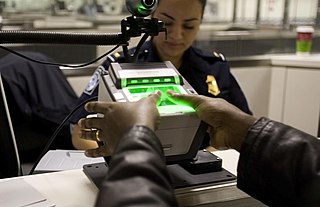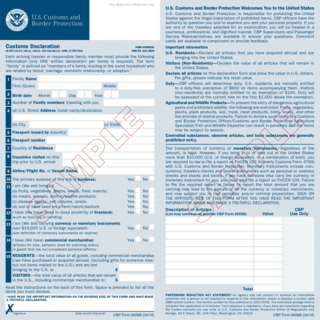Related Research Articles

Customs is an authority or agency in a country responsible for collecting tariffs and for controlling the flow of goods, including animals, transports, personal effects, and hazardous items, into and out of a country. Traditionally, customs has been considered as the fiscal subject that charges customs duties and other taxes on import and export. In recent decades, the views on the functions of customs have considerably expanded and now covers three basic issues: taxation, security, and trade facilitation.
UN/CEFACT is the United Nations Centre for Trade Facilitation and Electronic Business. It was established as an intergovernmental body of the United Nations Economic Commission for Europe (UNECE) in 1996 and evolved from UNECE's long tradition of work in trade facilitation which began in 1957.

United States Visitor and Immigrant Status Indicator Technology is a U.S. Customs and Border Protection (CBP) management system. The system involves the collection and analysis of biometric data, which are checked against a database to track individuals deemed by the United States to be terrorists, criminals, and illegal immigrants. US-VISIT is accessed by 30,000 users from federal, state, and local government agencies. Upon Presidential approval of the 2013 Continuing resolution the US-VISIT program officially became the Office of Biometric Identity Management (OBIM), save for portions of the agency which performed overstay analysis being transferred into U.S. Immigration and Customs Enforcement and biometric Entry and Exit operations which became a part of U.S. Customs and Border Protection.

United States Customs and Border Protection (CBP) is the largest federal law enforcement agency of the United States Department of Homeland Security. It is the country's primary border control organization, charged with regulating and facilitating international trade, collecting import duties, as well as enforcing U.S. regulations, including trade, customs and immigration. CBP is one of the largest law enforcement agencies in the United States. It has a workforce of more than 45,600 federal agents and officers. It is headquartered in Washington, D.C.
A passenger name record (PNR) is a record in the database of a computer reservation system (CRS) that contains the itinerary for a passenger or a group of passengers travelling together. The concept of a PNR was first introduced by airlines that needed to exchange reservation information in case passengers required flights of multiple airlines to reach their destination ("interlining"). For this purpose, IATA and ATA have defined standards for interline messaging of PNR and other data through the "ATA/IATA Reservations Interline Message Procedures - Passenger" (AIRIMP). There is no general industry standard for the layout and content of a PNR. In practice, each CRS or hosting system has its own proprietary standards, although common industry needs, including the need to map PNR data easily to AIRIMP messages, has resulted in many general similarities in data content and format between all of the major systems.
Form I-94, the Arrival-Departure Record Card, is a form used by U.S. Customs and Border Protection (CBP) intended to keep track of the arrival and departure to/from the United States of people who are not United States citizens or lawful permanent residents. While the form is usually issued by CBP at ports of entry or deferred inspection sites, USCIS can issue an equivalent as part of the Form I-797A approval notice for a Form I-129 petition for an alien worker or a Form I-539 application for extension of stay or change of status.

NEXUS is a joint Canada Border Services Agency and U.S. Customs and Border Protection-operated Trusted Traveler and expedited border control program designed for pre-approved, low-risk travelers. Members of the program can avoid waits at border entry points by using reserved lanes at land crossings into Canada and the United States, by using self-serve kiosks at airports in Canada, the US and some international locations, or by phoning border officials for a marine entry. A NEXUS membership card is a valid document under the Western Hemisphere Travel Initiative (WHTI), so it can be used in place of a passport, including by air if flying between the US and Canada. However, carrying a valid passport is still recommended, in the rare event that a flight is diverted to an airport without NEXUS support.
The Electronic System for Travel Authorization (ESTA) is an automated system that determines the eligibility of visitors to travel to the United States under the Visa Waiver Program (VWP). ESTA was mandated by the Implementing Recommendations of the 9/11 Commission Act of 2007. ESTA only authorizes travel to a U.S. airport, border or port of entry, but admissibility into the United States is determined by a U.S. Customs and Border Protection (CBP) officer upon arrival. The ESTA application collects biographic information and answers to VWP eligibility questions.

SmartGate is an automated self-service border control system operated by the Australian Border Force and New Zealand Customs Service and located at immigration checkpoints in departure and arrival halls in ten Australian international airports, and 4 New Zealand international airports. SmartGates allow Australian ePassport holders and ePassport holders of a number of other countries to clear immigration controls more rapidly, and to enhance travel security by performing passport control checks electronically.

An arrival card, also known as an incoming passenger card, landing card or disembarkation card, is a legal document used by immigration authorities of many countries to obtain information about incoming passenger not provided by the passenger's passport and to provide a record of a person's entry into the country. The card may also provide information on health and character requirements for non-citizens entering the country. Some countries require an arrival card for each incoming passenger, while others require one card per family unit, and some only require an arrival card for non-citizens only.

Global Entry is a program of the U.S. Customs and Border Protection service that allows pre-approved, low-risk travelers to receive expedited clearance upon arrival into the United States through automatic kiosks at select airports and via the SENTRI and NEXUS lanes by land and sea. As of May 4, 2018, Global Entry was available at 53 U.S. airports and 15 preclearance locations. By April 2018 more than five million people were enrolled in Global Entry and approximately 50,000 new applications for the program were being filed each month.

U.S. citizens and permanent residents entering Canada by land are required to possess the requisite documentation, such as a passport, driver's license, and other valid identification documents. They must also meet other criteria, such as passing security measures, before they are allowed entry into Canada. Consequently, travelers must also meet the requirements for re-entering the U.S. at the end of their visit.
The Importer Security Filing (ISF) also referred to as 10+2, is a customs import requirement of the United States Customs and Border Protection (CBP) ; which requires containerized cargo information, for security purposes, to be transmitted to the agency at least 24 hours (19 CFR section 149.2 before goods are loaded onto an ocean vessel headed to the U.S. for shipment into the U.S. 10+2 is pursuant to section 203 of the SAFE Port Act, and requires importers to provide 10 data elements to CBP, as well as 2 more data documents from the carrier.

Visa requirements for Mexican citizens are administrative entry restrictions by the authorities of other states placed on citizens of Mexico. As of May 2023, Mexican citizens had visa-free or visa on arrival access to 162 countries and territories ranking the Mexican passport 22nd in terms of travel freedom according to the Henley Passport Index.
Visa requirements for Paraguayan citizens are administrative entry restrictions imposed by the authorities of foreign states on citizens of Paraguay.As of July 20, 2023, Paraguayan citizens had visa-free or visa on arrival access to 144 countries and territories, ranking the Paraguayan passport 32nd in the world in terms of travel freedom according to the Henley Passport Index.

Visa requirements for Maldivian citizens are administrative entry restrictions by the authorities of other states placed on citizens
Visa requirements for Sammarinese citizens are administrative entry restrictions by the authorities of other states placed on citizens of San Marino. As of July 2023, San Marino citizens had visa-free or visa on arrival access to 173 countries and territories, ranking the San Marino passport 19th in terms of travel freedom according to the Henley Passport Index. Currently the San Marino passport is one of the four European "ordinary" passports to provide visa-free access to the People's Republic of China.
Visa requirements for crew members are administrative entry restrictions imposed by countries on members of the crew during transit or turnaround.
A customs declaration is a form that lists the details of goods that are being imported or exported when a citizen or visitor enters a customs territory. Most countries require travellers to complete a customs declaration form when bringing notified goods across international borders. Posting items via international mail also requires the sending party to complete a customs declaration form.
Mobile Passport is a mobile app that enables US and Canadian passport holders entering the United States to submit their passport information and customs declaration form to U.S. Customs and Border Protection (CBP) via smartphone or tablet and go through the inspections process using an expedited lane. Mobile Passport is available to U.S. passport holders and Canadian passport holders when entering the United States. The app is available on iOS and Android devices and is operational at 29 US airports, 10 international airports offering preclearance facilities, and 4 seaports. The use of Mobile Passport operations have increased threefold from 2016 to 2017.
References
- ↑ "APIS: Advance Passenger Information System". U.S. Customs and Border Protection. 17 May 2018. Retrieved 17 September 2019.
- ↑ US Customs and Border Protection Archived August 14, 2013, at the Wayback Machine
- ↑ ICAO Facilitation Section: Advance Passenger Information (API)
- ↑ FAL-12-WP-15 FACILITATION (FAL) DIVISION — TWELFTH SESSION Cairo, Egypt, 22 March to 2 April 2004 Agenda Item 2 Archived 12 November 2013 at the Wayback Machine
- ↑ "U.S. Customs and Border Protection - Travel". Archived from the original on 2012-03-03. Retrieved 2013-11-12.
- ↑ "Reporting Requirements Begin December 18 for Private Aircraft Arriving or Departing United States - CBP.gov". Archived from the original on 2012-10-30. Retrieved 2013-11-12.
- ↑ eAPIS Archived October 15, 2011, at the Wayback Machine
- ↑ "Welcome to eAPIS | Customs and Border Protection".
- ↑ aircanada.com – Travel Info – Advance Passenger Information
- 1 2 Which countries require Advanced Passenger Information? - FAQ (Air France, read 2018-03-09)
- 1 2 3 4 Advance information about passengers (Iberia, read 2018-03-09)
- ↑ Advanced Information Passenger System (SEF, read 2012-07-11)
- ↑ A.P.I.(Advanced Passenger Information|ANA